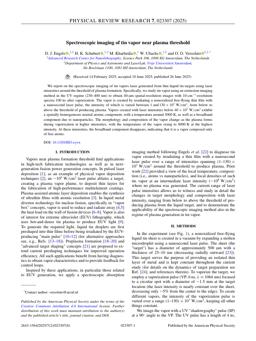2025-06-26
Spectroscopic imaging of tin vapor near plasma threshold
Publication
Publication
Phys. Rev. Res. , Volume 7 - Issue 2 p. 023307: 1- 8
We report on the spectroscopic imaging of tin vapors laser generated from thin liquid tin targets using laser intensities around the threshold of plasma formation. Specifically, we study tin vapor using an extinction imaging method in the UV regime (230–400 nm) to obtain 40−µm spatial-resolution images with 10−cm−1-resolution spectra 100ns after vaporization. The vapor is created by irradiating a nonoxidized free-flying thin film with a nanosecond laser pulse, the intensity of which is varied between 1 and 130×10^7 W/cm2, from below to above the threshold of producing plasma. Vapors created with laser intensities below 40×10^7 W/cm2 exhibit a spatially homogeneous neutral atomic component, with a temperature around 3000 K, as well as a broadband component due to nanoparticles. The morphology and composition of the vapor change as the plasma forms during vaporization at higher intensities, with the temperature of the vapor rising to 8000 K at the highest intensity. At these intensities, the broadband component disappears, indicating that it is a vapor composed only of free atoms.
| Additional Metadata | |
|---|---|
| APS | |
| ASML, ARCNL, VU, UvA, RUG, NWO , Dutch Ministry of Economic Affairs and Climate Policy , Netherlands Organisation for Scientific Research (NWO) | |
| doi.org/10.1103/f8l3-cyvx | |
| Phys. Rev. Res. | |
| Organisation | EUV Plasma Processes |
|
Engels, D., Schubert, H. K., Kharbedia, M., Ubachs, W., & Versolato, O. (2025). Spectroscopic imaging of tin vapor near plasma threshold. Phys. Rev. Res., 7(2), 023307: 1–8. doi:10.1103/f8l3-cyvx |
|

